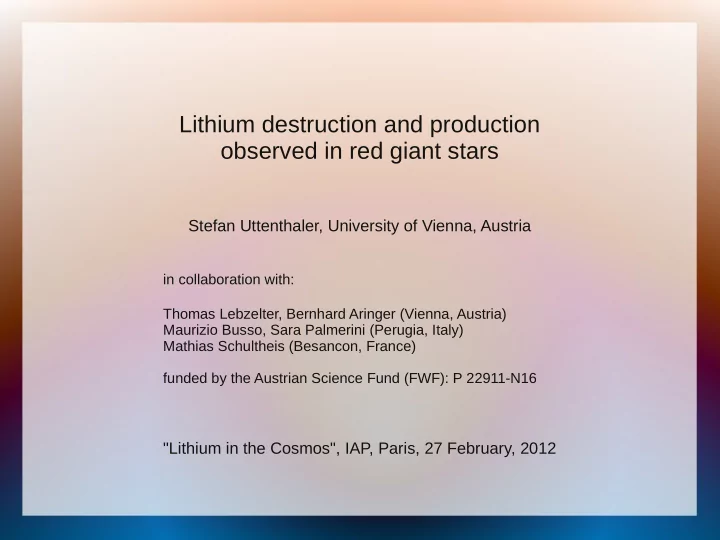

Lithium destruction and production observed in red giant stars Stefan Uttenthaler, University of Vienna, Austria in collaboration with: Thomas Lebzelter, Bernhard Aringer (Vienna, Austria) Maurizio Busso, Sara Palmerini (Perugia, Italy) Mathias Schultheis (Besancon, France) funded by the Austrian Science Fund (FWF): P 22911-N16 "Lithium in the Cosmos", IAP, Paris, 27 February, 2012
Overview 3 topics: ● Lithium survey in Galactic bulge RGBs (Lebzelter, Uttenthaler et al. 2012) ● Correlation between Lithium and TDUP indicator technetium (Tc) in O-rich low-mass AGBs ● Lithium and hot bottom burning in long-period Miras (AGB)
Destruction of Li throughout low-mass stellar evolution RGB bump, THM 1 st DU Lind et al. 2009
Motivation for the Lithium Bulge survey 1 – 2% of K-type giants are known to be abnormally rich in Li. This disagrees with results of "standard models" of stellar evolution. Previous claims for distinct Li-rich episode for low-mass stars at the RGB bump, and for intermediate-mass stars at the early AGB. Kumar, Reddy & Lambert (2011, blue sym.) Charbonnel & Balachandran, 2000
Further motivation Previous detection of Li-rich AGB stars in the Galactic bulge (Uttenthaler et al. 2007). How much Li is already present in RGB stars? Bulge offers a huge number of low-mass giant stars at roughly equal distance! 2MASS, ( l , b )=(0°,–10°) ~400 bulge RGB stars observed with FLAMES@VLT Published in Lebzelter, Uttenthaler, et al., 2012, A&A, 538, 36
Results ● Li already present on the RGB. Use asteroseismology to disentangle RGB from E-AGB stars! ● No distinct episode of Li enhancement Li-detected (log (Li)≤1.5) Li-rich stars (log (Li)>1.5) #042: log (Li)=+3.2
Fraction of Li-detected stars Fraction of Li-detected stars is higher on the upper RGB, but no obvious concentration at a certain magnitude. Same conclusion in other recent studies (Gonzalez et al. 2009, Monaco et al. 2011, Ruchti et al. 2011). A distinct episode of Li enhancement on the RGB is very questionable. RGB bump / red clump
Trend of log (Li) with T eff for Li-detected stars Where does this trend come from, and what does it tell us?
Enhanced mass loss from Li-rich stars? cf. de La Reza et al. (1996, 1997) Lebzelter et al. (2012) Photospheric colours No enhanced dust mass-loss rate from Li-rich stars! Most of K – [12] red stars are either T Tauri or post-AGB stars. Externeal mechanism of Li enhancement (planet engulfment) unlikely! Internal mechanism: Magnetic fields? (Busso et al 2007, Palmerini et al. 2011)
Lithium in low-mass AGB stars (Miras)
AGB: Correlation between Li and TDUP indicator Tc Analysis of Li and the radio-active Uttenthaler & Lebzelter (2010) s-process element technetium (Tc) shows that these elements tend to go together, and that more luminous stars tend to have Li with a higher probability. Uttenthaler et al. 2007 Uttenthaler & Lebzelter 2010 Uttenthaler et al. 2011 O-rich disc AGB stars: p (Li | Tc no) = 43.8 % p (Li | Tc yes) = 80.0 % Dredge-up of Li in low-mass AGB stars predicted by standard models (Karakas et al. 2010).
Lithium and hot bottom burning in long-period Miras
Lithium and hot bottom burning in long-period Miras Galactic super Li-rich Miras indentified by García-Hernández et al. 2007. Li very enhanced for P ≥ 400d. Also the O-rich Miras R Nor (P=496d, Uttenthaler et al. 2011) and R Cen (P=538d) are found to be extremely enhanced in Li: log (Li)=+4.8! Uttenthaler et al. 2011 Long pulsation period and high Li abundance are indicators of intermediate-mass AGB stars (M ≳ 4 M ⊙ ). These stars can be of importance in the cosmological context (Lind et al. 2009).
Thanks for your attention! Note: The colour of the 671 nm Li transition is approximately the same as that of my shirt.
Conclusions 1) Lack of distinct episode of Li enhancement in low-mass RGB stars. 2) No mass loss from Li-rich stars → internal enrichment mechanism?! 3) Trend of log (Li) with T eff 4) Fraction of Li-detected stars on the upper RGB comparable to fraction of Li-rich AGB stars. Li might be "inherited" from the RGB. 5) Dredge-up of Li in low-mass AGB stars. 6) Extreme Li abundance an indicator of high mass of long-period Miras, enrichment of ISM with Li in some phases.
Enhanced mass loss from Li-rich stars? No asymmetries in H line profile, no gas mass loss!
No particular Li-rich phase found in recent studies Monaco et al. (2011, Li-rich giants in the Thick Disk, 824 sample stars) Ruchti et al. (2011, low-metallicity stars from RAVE)
No particular Li-rich phase found in recent studies RC Gonzalez et al., 2009
Recommend
More recommend